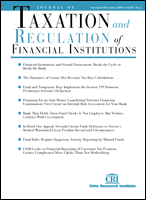Complete Issue
Author: Houman B. Shadab.
Source: Volume 26, Number 01, September/October 2012 , pp.1-60(60)

< previous article |return to table of contents
Abstract:
The flow-through nature of partnerships makes them attractive to financial institutions seeking to structure transactions with third parties so as to minimize tax liabilities. This issue’s first article, by Patricia McDonald, discusses the potential pitfalls of leveraged partnership structures in light of the increasing attention being paid to them by U.S. tax authorities. Ms. McDonald focuses her analysis on what investment funds and other financial institutions should do, in light of recent court opinions, to avoid having such partnership transactions characterized as disguised sales. Our second article also focuses on investment funds, but from a regulatory perspective. Jennifer V. Audeh and Jeffrey D. Collins provide a wide-ranging overview of the new rules for investment funds and their advisers. The authors not only cover rulemaking by the Securities and Exchange Commission pursuant to the Dodd-Frank Act, but also recent reforms undertaken by the Financial Industry Regulatory Authority, the U.S. Commodities Futures Trading Commission, the Department of Labor, and the Cayman Islands Monetary Authority. Andrew Immerman and Heather Ripley, in our third article, discuss the tax consequences of reorganizations by nonstock banking institutions, addressing the tax treatment of nonstock interests in light ofthe stock-centric approach of the Internal Revenue Code and certain judicial doctrines. All financial institutions, whether they issue stock or not, face risk management challenges. Our fourth article, by Brian C. McCormally, Christopher L. Allen, and Helen E. Mayer, considers these ongoing risk management issues. The authors focus their analysis on enterprise risk management (ERM)—and how an ERM program can be established to reduce risk and meet the expectations of regulators. Rounding out this issue, recent developments in litigation relating to commercial mortgage-backed securities (CMBS) are discussed in our final article, by Mark R. Owens. After providing a brief primer on CMBS, Mr. Owens discusses recent case law on the issue of when full-recourse provisions in commercial loan agreements are triggered by borrower insolvency that pierce their generally non-recourse structure.Keywords: Leveraged partnership taxation; Dodd-Frank rules for investment funds; tax-free reorganizations; risk management; borrower insolvency
Affiliations:
1: New York Law School.